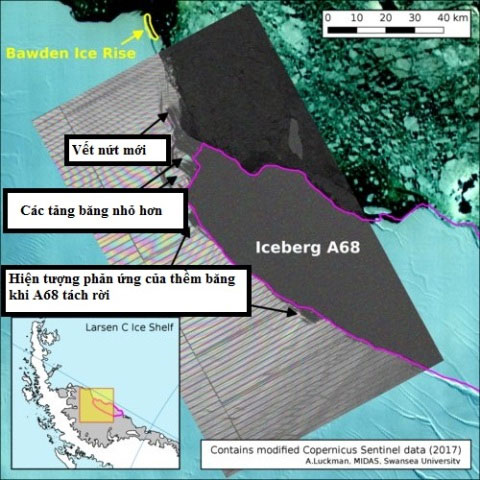New cracks appear after the trillions of ice caps have just split off from Antarctica
Just a week after the ice sheet weighed one trillion tons off the Antarctic, a new crack appeared on the ice in this area.
According to RT TV channel, this new loophole was discovered by scientists from the MIDAS Project . The MIDAS project is a closely monitoring group operating on the Larsen C ice shelf and is also the first group to detect the crack of the A68 iceberg - a trillion tons of ice separating last week.
In a MIDAS Project statement, the researchers said that by using the Sentinel-1 interference data collected, on July 18, they discovered a new crack that extended north and had could result in the ice shelf area being further lost.

New cracks appear after the A68 ice sheet separates from Larsen C.
'We found a new crack of about 6km to the north from the crack formed by the separation last week' , Adrian Luckman - Glacier professor at Swansea University and the head of the MIDAS project - identify.
However, according to Professor Luckman, there is still nothing to worry about, because the crack head is still in the stitch zone - a softer area of ice - and hard to crack longer in the future.
Last week, a thousand billion tons of 6,000km 2 ice sheet A68 was removed from Larsen C. This is one of the largest recorded ice sheets. The fact that the separation band has caused the Larsen C ice shelf area to be reduced by 12%.
Although the fissures that caused the massive ice breaking off the Larsen C platform were discovered by scientists in the 1980s, it was not until the beginning of January 2017 that the ice sheet began to separate. It is currently floating on the Weddell Sea.
Many experts doubt whether the impact of climate change will affect the A68 ice sheet from the ice shelf, but MIDAS project researcher Bryn Hubbard - Aberystwyth University's ice research center - It is difficult to determine.
- The appearance of huge fissures, evidence of Africa began to split into two, forming a new continent
- Video: According to you, how big is the trillion dollar figure?
- Russian task force will wear bulletproof caps made from recycled materials
- Video: Death cracks devour the river after a night
- The soil cracked an unprecedented giant split the African continent
- The one trillion tons of ice has separated from Antarctica
- The world's largest iceberg is at risk of breaking away from Antarctica
- Do people with brains split apart, are their souls divided into two different halves?
- Nearly twice the broadband of Hanoi is about to drift away from Antarctica
- The hat is anti-hair loss when chemotherapy
- Giant cracks in Tibet can forecast horrific disasters
- The giant split in Africa is getting bigger and bigger, but what does this mean?
 Is the magnetic North Pole shift dangerous to humanity?
Is the magnetic North Pole shift dangerous to humanity? Washington legalizes the recycling of human bodies into fertilizer
Washington legalizes the recycling of human bodies into fertilizer Lightning stone - the mysterious guest
Lightning stone - the mysterious guest Stunned by the mysterious sunset, strange appearance
Stunned by the mysterious sunset, strange appearance